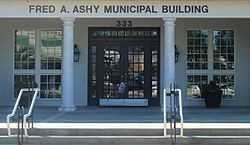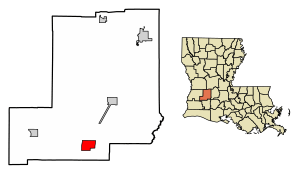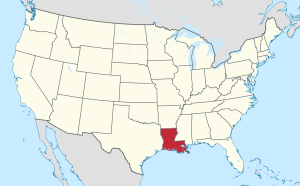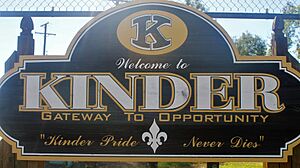Kinder, Louisiana facts for kids
Quick facts for kids
Kinder, Louisiana
|
|
|---|---|
|
Town
|
|

Ashy Municipal Building is named for former Kinder Mayor Fred A. Ashy
|
|

Location of Kinder in Allen Parish, Louisiana.
|
|

Location of Louisiana in the United States
|
|
| Country | United States |
| State | Louisiana |
| Parish | Allen |
| Town | 1911 |
| Government | |
| • Type | Mayor and Town Council |
| Area | |
| • Total | 5.53 sq mi (14.31 km2) |
| • Land | 5.53 sq mi (14.31 km2) |
| • Water | 0.00 sq mi (0.00 km2) |
| Elevation | 46 ft (14 m) |
| Population
(2020)
|
|
| • Total | 2,170 |
| • Density | 392.76/sq mi (151.64/km2) |
| Time zone | UTC-6 (CST) |
| • Summer (DST) | UTC-5 (CDT) |
| ZIP code |
70648
|
| Area code(s) | 337 |
| FIPS code | 22-39755 |
Kinder is a small town located in Allen Parish, Louisiana, in the United States. In 2020, about 2,170 people lived there.
A special place called the Lieutenant Douglas B. Fournet Memorial Park was opened in Kinder on June 11, 1988. This park remembers people who served and died in the military.
Kinder was also the hometown of J. Rayburn Bertrand, who became the mayor of Lafayette. He was mayor from 1960 to 1972, and during his time, Lafayette's population almost doubled!
Today, Kinder is known for the Coushatta Casino Resort, which is the largest casino resort in Louisiana. It also has a big golf course called Koasati Pines.
Contents
Geography of Kinder
Kinder is located in Louisiana at coordinates 30.486696 degrees North and 92.846779 degrees West.
The town covers a total area of about 14.3 square kilometers (5.5 square miles). All of this area is land, meaning there are no large bodies of water like lakes or rivers within the town limits.
Population Changes in Kinder
The number of people living in Kinder has changed over the years. Here's a look at how the population has grown and shrunk since 1910:
| Historical population | |||
|---|---|---|---|
| Census | Pop. | %± | |
| 1910 | 635 | — | |
| 1920 | 1,148 | 80.8% | |
| 1930 | 962 | −16.2% | |
| 1940 | 1,416 | 47.2% | |
| 1950 | 2,003 | 41.5% | |
| 1960 | 2,299 | 14.8% | |
| 1970 | 2,307 | 0.3% | |
| 1980 | 2,603 | 12.8% | |
| 1990 | 2,246 | −13.7% | |
| 2000 | 2,148 | −4.4% | |
| 2010 | 2,477 | 15.3% | |
| 2020 | 2,170 | −12.4% | |
| U.S. Decennial Census | |||
Who Lives in Kinder?
In 2020, there were 2,170 people living in Kinder. They made up 973 households and 649 families.
The town is home to people from many different backgrounds. Here's a quick look at the different groups:
| Race | Number | Percentage |
|---|---|---|
| White (non-Hispanic) | 1,480 | 68.2% |
| Black or African American (non-Hispanic) | 453 | 20.88% |
| Native American | 44 | 2.03% |
| Asian | 27 | 1.24% |
| Pacific Islander | 1 | 0.05% |
| Other/Mixed | 100 | 4.61% |
| Hispanic or Latino | 65 | 3.0% |
Famous People from Kinder
Many interesting people have come from Kinder, Louisiana. Some of them include:
- Beau Jocque, a famous zydeco musician.
- Bruston Manuel, a Tony Award-winning producer for Broadway shows.
- Blake Trahan, a former professional baseball player.
- Douglas B. Fournet, a brave United States Army officer who received the Medal of Honor after he died during the Vietnam War.
- Roy Brown, a well-known Blues Musician.
History of Kinder
The town of Kinder is named after James A. Kinder. He was a soldier during the Civil War. After the war, he moved to Louisiana. In 1870, he settled in Rapides Parish. Later, he moved south to the area that would become Kinder.
James Kinder built a home and a store where two main highways, Highway 165 and Highway 190, now meet. His customers called his store Kinder's Store.
In 1892, a man named Jabez Bunting Watkins bought Kinder's land. Watkins was building a railroad, the Watkins, Kansas City and Gulf Railroad, and it passed through Kinder. After selling his land, James Kinder moved to Lake Charles.
Becoming a Village and Town
After buying the land, J.B. Watkins hired John W. Rhorer to plan out the streets for a new town. In 1903, the governor of Louisiana, William Wright Heard, officially declared the area the Village of Kinder.
Some of the first families to move to Kinder were employees of J.B. Watkins. These included Milton B. McRill, John M. Houston, and Philetus Philbrick.
Milton B. McRill helped build 100 miles of railroad. He bought land and built the very first home in Kinder. McRill later became one of Kinder's early mayors. He strongly believed in education and often let teachers stay in his home.
John M. Houston worked as an office manager and surveyor for the railroad. He bought timber land north of Kinder and built a sawmill there. This area became known as the "Houston spur."
Philetus Philbrick was a professor from the University of Iowa. He came to Kinder as a railroad surveyor. He wrote to his brother, Franklin, telling him about the good farmland. Franklin Philbrick moved his family to Kinder and bought a farm. He even opened the first school and taught for free for three months until the state could provide a teacher.
Many other families from the Midwest moved to Kinder between 1880 and 1900. J.B. Watkins spent a lot of money telling people about the "Garden of Eden" in southwest Louisiana. Some of these new families included the Storers, Mayfields, and Johnsons.
By 1903, when Kinder became a village, more families had arrived. Patrick E. Moore was appointed the first mayor. Dr. R.E. Oden, Fred Moore, Edoc Roza, and J.W. Kingrey became the first town council members.
In 1911, Kinder had grown to a population of 1,088 people. Because of this growth, Governor Jared Young Sanders officially declared Kinder a town on March 4, 1911.
Many people have served as mayor of Kinder over the years. Some of them include Patrick Moore, Jack Dempsey, Dr. R.E. Oden, and Fred Ashy, for whom the municipal building is named.
Louisiana Maneuvers in Kinder
Kinder played an important role during the Louisiana Maneuvers. These were large military training exercises that happened before the United States entered WWII. Kinder was used as the main base for the "Blue Army" during these drills. A special marker by the road remembers this important event.
Education in Kinder
The Allen Parish Public Schools system runs the schools in Kinder. Students in Kinder attend:
- Kinder High School
- Kinder Middle School
- Kinder Elementary School
Images for kids
See also
 In Spanish: Kinder (Luisiana) para niños
In Spanish: Kinder (Luisiana) para niños





